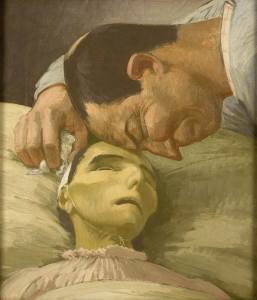Death of a Peasant
While staying with the Favennec family in Doëlan, Brittany, during the summer of 1910, Henry Lamb witnessed the death of Madame Favennec, the mother of twelve children. Her throat was constricted by cancer and, unable to eat, she was emaciated by the time she died. Shocked and moved by this event, Lamb painted the deathbed scene on his return to England in the spring of 1911. The painting was the artist’s first critical success, prompting Frank Rutter to remark, ‘His modern pieta “The Death of a Peasant” was the first great tragic picture England produced in the 20th Century.’ It was subsequently acquired by the Tate Gallery. The present work is the second, almost identical but slightly larger version of this subject. He described the work as ‘a technical experiment’, as he had employed a fifteenth-century method of painting in oils over a layer of reddish-brown tempera. This had the effect of preserving the translucent quality of the oil paint and also contributes to the luminous quality of Monsieur Favennec’s skin. It was the first of the two paintings to be exhibited at the New English Art Club in 1911 and was, according to Lamb, ‘incomparably finer than the first version’. Lamb has expressively conveyed the essentials of the story – the horrific circumstances of the woman’s death and the intense grief experienced by her husband. The figures’ heads occupy most of the picture space, and are shown almost life sized in a composition stripped of extraneous detail. The close-up view, unsparing depiction of the physical details of death and grief, stark composition, and cold palette of grey-blue, greenish-yellow and grey-white all contribute to the intensity of the scene and compel the viewer to bear witness. Lamb’s expressionist treatment with its deliberately awkward modelling, shallow space and close-up viewpoint shows his response to Gauguin, in 1910 still a pervasive influence in Brittany.


Leave a Reply
Want to join the discussion?Feel free to contribute!